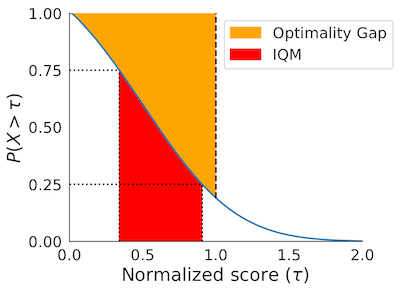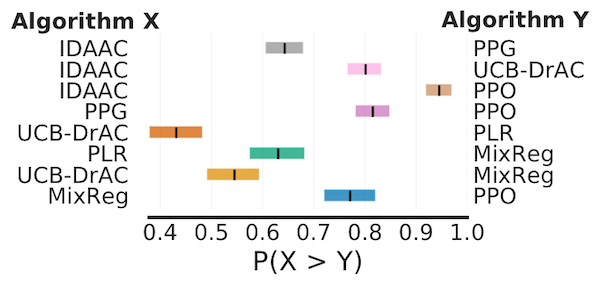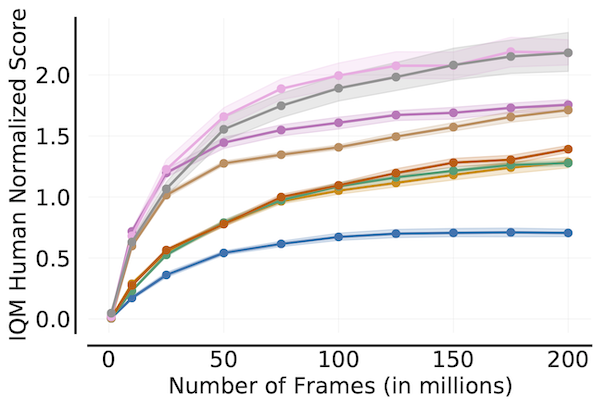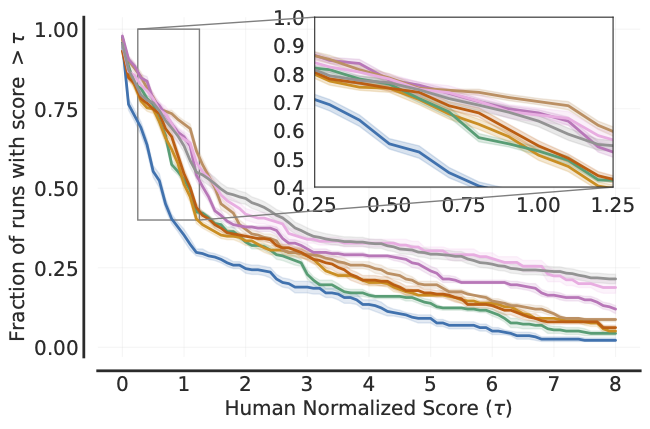rliable 是一个开源 Python 库,用于对强化学习和机器学习基准进行可靠评估,即使只有少量运行结果。
| 要求 | 当前评估方法 | 我们的建议 |
|---|---|---|
| 总体性能的不确定性 | 点估计:
| 使用分层自助抽样置信区间 (CI) 的区间估计 |
| 跨任务和运行的性能变异性 | 任务平均分数表:
| 分数分布 (性能曲线):
|
| 总结基准性能的汇总指标 | 均值:
| 所有运行的四分位均值 (IQM):
|
rliable 提供以下支持:
- 分层自助抽样置信区间 (CI)
- 性能曲线(带绘图功能)
- 汇总指标
- 所有运行的四分位均值 (IQM)
- 最优性差距
- 改进概率

交互式 Colab
我们在 bit.ly/statistical_precipice_colab 提供了一个 Colab,展示了如何使用该库,并提供了在广泛使用的基准(包括 Atari 100k、ALE、DM Control 和 Procgen)上发布算法的示例。
Atari 100k、ALE、DM Control 和 Procgen 的单次运行数据
您可以通过此公共 GCP 存储桶访问单次运行的数据(您可能需要使用 Gmail 账户登录才能使用 Gcloud):https://console.cloud.google.com/storage/browser/rl-benchmark-data。 上述交互式 Colab 还允许您以编程方式访问数据。
论文
欲了解更多详情,请参阅随附的 NeurIPS 2021 论文(杰出论文奖): Deep Reinforcement Learning at the Edge of the Statistical Precipice。
安装
要安装 rliable,请运行:
pip install -U rliable
要安装 rliable 的最新版本作为包,请运行:
pip install git+https://github.com/google-research/rliable
要导入 rliable,我们建议:
from rliable import library as rly
from rliable import metrics
from rliable import plot_utils
带有 95% 分层自助抽样置信区间的汇总指标
IQM、最优性差距、中位数、均值
algorithms = ['DQN (Nature)', 'DQN (Adam)', 'C51', 'REM', 'Rainbow',
'IQN', 'M-IQN', 'DreamerV2']
# 加载 ALE 分数作为字典,将算法映射到其人类归一化
# 分数矩阵,每个矩阵的大小为 `(运行次数 x 游戏数)`。
atari_200m_normalized_score_dict = ...
aggregate_func = lambda x: np.array([
metrics.aggregate_median(x),
metrics.aggregate_iqm(x),
metrics.aggregate_mean(x),
metrics.aggregate_optimality_gap(x)])
aggregate_scores, aggregate_score_cis = rly.get_interval_estimates(
atari_200m_normalized_score_dict, aggregate_func, reps=50000)
fig, axes = plot_utils.plot_interval_estimates(
aggregate_scores, aggregate_score_cis,
metric_names=['中位数', 'IQM', '均值', '最优性差距'],
algorithms=algorithms, xlabel='人类归一化分数')

改进概率
# 将ProcGen分数加载为包含我们想要比较的算法对归一化分数矩阵对的字典
procgen_algorithm_pairs = {.. , 'x,y': (score_x, score_y), ..}
average_probabilities, average_prob_cis = rly.get_interval_estimates(
procgen_algorithm_pairs, metrics.probability_of_improvement, reps=2000)
plot_utils.plot_probability_of_improvement(average_probabilities, average_prob_cis)

样本效率曲线
algorithms = ['DQN (Nature)', 'DQN (Adam)', 'C51', 'REM', 'Rainbow',
'IQN', 'M-IQN', 'DreamerV2']
# 将ALE分数加载为字典,将算法映射到其在所有2亿帧中的人类归一化分数矩阵,
# 每个矩阵大小为`(运行次数 x 游戏数量 x 200)`,其中每百万帧记录一次分数。
ale_all_frames_scores_dict = ...
frames = np.array([1, 10, 25, 50, 75, 100, 125, 150, 175, 200]) - 1
ale_frames_scores_dict = {algorithm: score[:, :, frames] for algorithm, score
in ale_all_frames_scores_dict.items()}
iqm = lambda scores: np.array([metrics.aggregate_iqm(scores[..., frame])
for frame in range(scores.shape[-1])])
iqm_scores, iqm_cis = rly.get_interval_estimates(
ale_frames_scores_dict, iqm, reps=50000)
plot_utils.plot_sample_efficiency_curve(
frames+1, iqm_scores, iqm_cis, algorithms=algorithms,
xlabel=r'帧数(百万)',
ylabel='IQM人类归一化分数')


性能剖面
# 将ALE分数加载为字典,将算法映射到其人类归一化分数矩阵,
# 每个矩阵大小为`(运行次数 x 游戏数量)`。
atari_200m_normalized_score_dict = ...
# 人类归一化分数阈值
atari_200m_thresholds = np.linspace(0.0, 8.0, 81)
score_distributions, score_distributions_cis = rly.create_performance_profile(
atari_200m_normalized_score_dict, atari_200m_thresholds)
# 绘制分数分布
fig, ax = plt.subplots(ncols=1, figsize=(7, 5))
plot_utils.plot_performance_profiles(
score_distributions, atari_200m_thresholds,
performance_profile_cis=score_distributions_cis,
colors=dict(zip(algorithms, sns.color_palette('colorblind'))),
xlabel=r'人类归一化分数 $(\tau)$',
ax=ax)


上述剖面也可以使用非线性缩放进行绘制,如下所示:
plot_utils.plot_performance_profiles(
perf_prof_atari_200m, atari_200m_tau,
performance_profile_cis=perf_prof_atari_200m_cis,
use_non_linear_scaling=True,
xticks = [0.0, 0.5, 1.0, 2.0, 4.0, 8.0]
colors=dict(zip(algorithms, sns.color_palette('colorblind'))),
xlabel=r'人类归一化分数 $(\tau)$',
ax=ax)
依赖项
代码在Python>=3.7下测试,并使用以下包:
- arch == 5.3.0
- scipy >= 1.7.0
- numpy >= 0.9.0
- absl-py >= 1.16.4
- seaborn >= 0.11.2
引用
如果您发现这个开源发布有用,请在您的论文中引用:
@article{agarwal2021deep,
title={Deep Reinforcement Learning at the Edge of the Statistical Precipice},
author={Agarwal, Rishabh and Schwarzer, Max and Castro, Pablo Samuel
and Courville, Aaron and Bellemare, Marc G},
journal={Advances in Neural Information Processing Systems},
year={2021}
}
免责声明:这不是谷歌的官方产品。

 访问官网
访问官网 Github
Github 论文
论文












